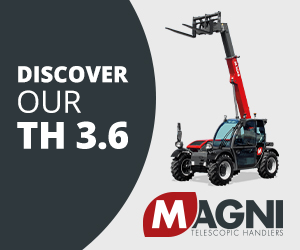)
Components for the W
Manufacturers of ancillary equipment have a big role to play at Global Lifting Awareness Day, says Joel Cox.
I was at the Cleanpower show in San Antonio, Texas last month (May) when a group of young people, each with a big ‘W’ on their tops, came over to our exhibit. They were unmistakably students at University of Wisconsin-Madison. The institutional logo, a combination of the enduring ‘W’ crest and ‘Wisconsin’ wordmark, has been core to the university’s visual identity since the late 1980s. The Wisconsin Energy Institute is based there.
We got into a conversation about our role in the industry, and the students were telling me about taking part in the country’s most prominent undergraduate-level wind energy programme – the Collegiate Wind Competition – for the seventh consecutive year at that event. The competition challenges undergraduate teams to develop a wind energy project and design, build, and test a model wind turbine. (Kansas State University eventually rose above 11 other competing teams to claim first place.)
It was easy then to explain where heavy-duty rotor, yaw, and pitch brakes are used in various wind energy applications. As I explained, rotor brakes are typically calliper style (active or passive) and Dellner offers rotor lock style pins (hydraulic, manual) for safety locking and maintenance purposes. Yaw brakes (active or passive) and sliding bearings along with special brakes are installed for pitch movement on the blades. They understood; we made an instant connection.
Richard Burgos, our new head of sales – wind (Americas), soon joined the conversation, telling them how he started in sales after completing a term in the US Marine Corps. His first job was selling consumer electronics before transitioning into wireless platforms, internet of things, data analytics, and eventually joining General Electric. Now, as he said, he’s responsible for introducing, among other things, a range of remote monitoring, diagnostics, and intelligence technologies to wind energy stakeholders. The students’ interest was further piqued.
It was the same kind of story at the prior Association for Iron & Steel Technology (AIST) show. A young audience, thirsty for information, descended on Pittsburgh, Pennsylvania where, again, our components proved to be the gateway to discussions about equipment, like overhead cranes, that keeps an entire industry on the move, or in the air.
As I’ve written before, we have spearheaded an awareness campaign centred on the importance of installing emergency brakes, especially in environments where critical lifts are commonplace. Electric overhead travelling (EOT) cranes are ubiquitous in steel mills and other industrial facilities, where they can be up to 450USt or more in capacity and lift ladles of molten metal that are poured into casting machines. Imagine therefore the catastrophic scene when, say, a gear shaft fractures and a load is dropped. The damage to property and inevitable injury, or worse, to workers is incalculable.
As Cleanpower and AISTech prove, young people ‘get’ ancillary equipment, and health and safety products, much faster than those now approaching retirement.
An industry for people
The real opportunity – W – here is that cranes and components have never been cooler or more accessible to younger generations. And that chimes perfectly with the third Global Lifting Awareness Day on 7 July. Industry is being encouraged to participate alongside the #GLAD2022 hashtag and I hope people don’t misperceive the event as being only for crane manufacturers, builders, and rigging guys. Us component folks have a massive opportunity to open another gateway to the industry – 4.0 style.
Often, the most exciting technology and commitment to sustainability is in the smallest components, yet it’s a product sector and wider industry that will constantly require people. It’s the best of both worlds. It doesn’t matter how much we automate or use robots, they’ve all got to be designed, fabricated, installed, monitored, maintained, inspected, etc. Every facet of our technological advancement needs smart, young, people to take it into the future. That’s something #GLAD2022 should really be shouting (and GLAD) about.
I like the Lifting Equipment Engineers Association’s (LEEA) military transition scheme too. It is designed to support the transition into the civilian lifting equipment industry for veterans and reservists within two years of leaving military service. Richard Burgos isn’t alone in possessing a wealth of experience, the best possible attitude, and an in-built appreciation of ancillary equipment, nurtured by a career in the forces. Ex-military personnel with transferable skills can potentially provide an important additional resource to our industry, which is why LEEA is, astutely, offering a package of benefits to such personnel.
Don’t worry, though, us industry stalwarts have a key part to play as well. Without us, we can’t successfully on-board all these young people, from universities, military, and elsewhere. There’s a time to lean on history and leverage legacy. I remember, for example, when technological feedback was represented by red and green lights. Green meant everything was ok, and red indicated that something needed attention. Now, we offer products with five-line displays telling the user and operator what’s going on with every motion and feature, even if it’s underground at a remote mine or out at sea.
To know where an industry is going to, we need people that have seen where it’s coming from.
Making port
At the time of writing, we’re on the cusp of TOC Europe, one of the world’s leading shipping, ports, and terminal events, in Rotterdam, Holland; and Tower Cranes North America takes place the following week in Miami, Florida. All happening in the ramp up to #GLAD2022, now is the time to shout about our industry, whether you build the biggest cranes or the smallest components. It is tempting to talk about logistics, freight costs, wars, and pandemics, but the next generation of workforce is aware of all that already. We need to sell ourselves, regardless.
Where else can you process an order to fit emergency brakes on massive hot metal ladle cranes? What other industry allows you to work high in the sky and deep underground, where the latest tech records characteristic current and voltage variations, which are induced by movements of the armature disk in the magnetic field of brake coils?
And did I mention that we defy gravity, every second of every minute of every day?
Now that’s a W.











